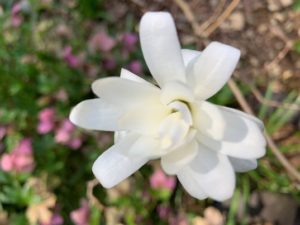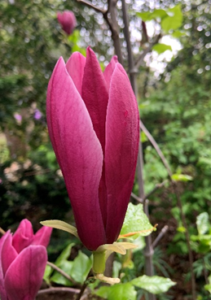To many people, the word “magnolia” is synonymous with the classic Southern tree with large, glossy leaves and huge, fragrant white blossoms. But this ancient genus includes over 200 species that range from evergreen to deciduous, small to large, and white to nearly black flowers. The Lake Wilderness Arboretum features a collection of magnolias that highlights these differences.
Evergreen magnolias.
Most of the evergreen magnolias are related to Magnolia grandiflora which is native to the southeastern United States. This drought tolerant tree stands out for its year-round beauty but it does require some space, growing 60-80’ tall and as wide as 40’. The Legacy Garden at LWA has a Magnolia grandiflora ‘Edith Bogue’ (OL02), a vigorous clone of the southern magnolia that is noted for its exceptional hardiness. It rates as one of the best southern magnolias for the Pacific Northwest. This cultivar does not grow as tall as typical grandifloras, reaching a mature height and width of 25’ but does feature the large, very fragrant, ivory-white flowers from late spring through midsummer.
The evergreen Magnolia virginiana, commonly called sweet bay magnolia, is native to the coastal areas of southeastern United States north along the Atlantic coast to New York. The tree has aromatic spicy leaves and twigs and extremely fragrant flowers from June through September. Magnolia virginiana ‘Henry Hicks’ (OL06) glimmers in the wind due to the whitish-green undersides of the leaves. The tree flourishes in moist, acid soil such as the swamps in the eastern U.S. and along stream banks. This tree can be found in the fern grove area of the Legacy Garden.

Evergreen Magnolia
Deciduous magnolias with star flowers.
This group includes Kobus magnolia (M. kobus), Loebner magnolia (M. x loebneri), and star magnolia (M. stellata). All are cold-hardy, heat-tolerant, adaptable plants. Late frosts sometimes damage their early blooms.
Star Magnolia.
Magnolia stellata, a Japanese native, typically grows 15-20’ tall with a spreading, rounded crown. It is noted for its compact size and late winter to early spring bloom of star-shaped white flowers. A popular cultivar, Magnolia stellata ‘Royal Star’ (OL11), that has slightly larger and showier flowers than the species is planted in the Arboretum’s Legacy Garden.

Star Magnolia
Deciduous magnolias with saucer flowers.
This group includes the popular saucer magnolia (M. x soulangeana) and its myriad selections, often called tulip trees because of the shape and bright color of their flowers. The parent plants of saucer magnolias are M. denudata and M. liliflora, the lily magnolia. Related to these, but less tolerant of winter cold and summer heat, are the spectacular magnolias from western China and the Himalayas―Sargent magnolia (M. sargentiana) and Sprenger magnolia (M. sprengeri). Though their early flowers may fall victim to late freezes, one spring season with good blooms will quickly make you forget the disappointments of years past.

Lily Magnolia with saucer flowers
Lily Magnolia.
Magnolia liliflora, native to southwestern China, is a one of the smaller species found in the Magnolia genus. The Latin name means flowers like a lily. M. liliflora ‘Nigra’ (OL10), a cultivar featured at LWA produces narrow, dark reddish-purple flowers with pale purple insides.
Bigleaf magnolia.
Magnolia macrophylla (OL05, OL10) lives up to its name and produces leaves that can be almost 3 feet long, evoking a subtropical feel in your garden. You can’t help but appreciate the enormous leaves but you will also love their 12- to 14-inch wide, fragrant, bowl-shaped, white flowers. Native to the southeastern United States and Mexico, the tree can grow up to 40’ tall. Look for these wonderful trees in two different locations in the Legacy Garden.

Bigleaf Magnolia
Hybrid Magnolias.
Because botanists and gardeners can’t seem to help themselves, cultivars of magnolias have been created mixing different species of magnolias together to combine the great characteristics of one plant with another. The Lake Wilderness Arboretum currently has 3 different hybrids that showcase different pairings of parent plants.

Hybrid Magnolia
Magnolia ‘Elizabeth’ (OL12) is a deciduous pyramidal magnolia that over time grows to 20-35’ tall and features yellow flowers in early spring. It is a cross between M. acuminata and M. denudata.
Magnolia ‘Vulcan’ (OL02) was selected for its rich ruby red flowers.
In its own category is the deciduous Oyama magnolia (M. sieboldii, OL08a), native to western China. It bears drooping, cup-shaped, fragrant blooms after leaves emerge. Oyama magnolia is a superb plant for the woodland as it is accustomed to growing beneath the forest’s larger trees which is why you will find one growing near the Little Free Library in the woods at Lake Wilderness Arboretum.
Other magnolias.
Less widely planted―but deserving of greater attention―is a group of large-leafed native magnolias generally grown as bold accents or shade trees. Cucumber tree (M. acuminata) and its smaller sibling, yellow cucumber tree (M. a. subcordata), are the source of the yellow blossom color of many new hybrids. Bigleaf magnolia (M. macrophylla), umbrella magnolia (M. tripetala), Fraser magnolia (M. fraseri), and Ashe magnolia (M. ashei) are medium-size trees with huge leaves and large flowers that appear after the leaves unfurl.
